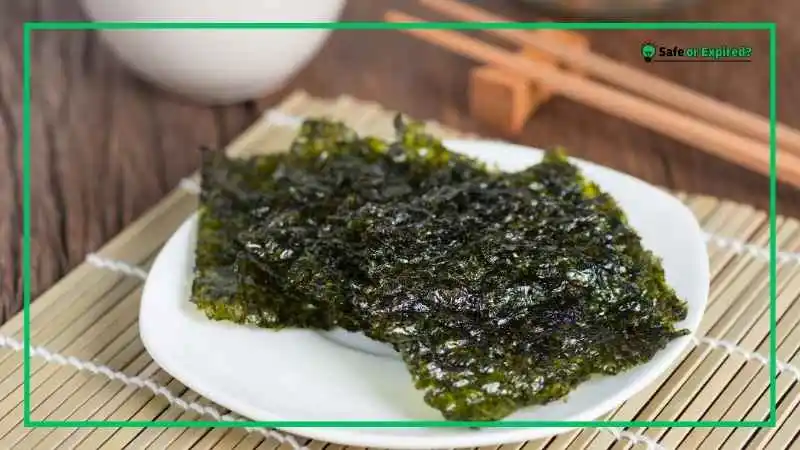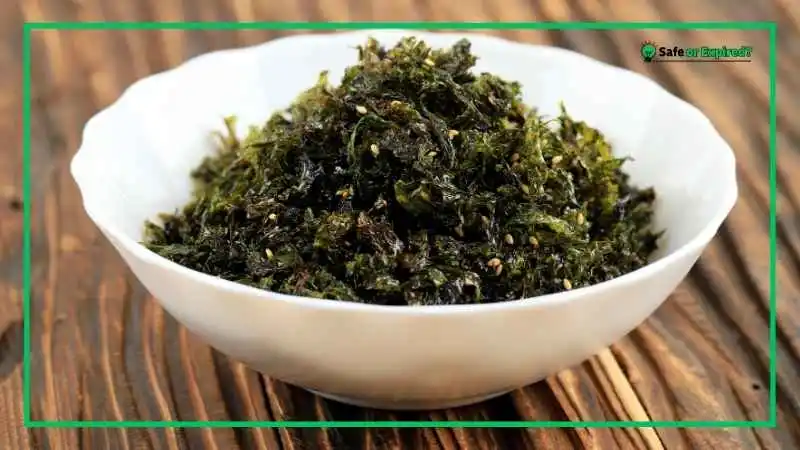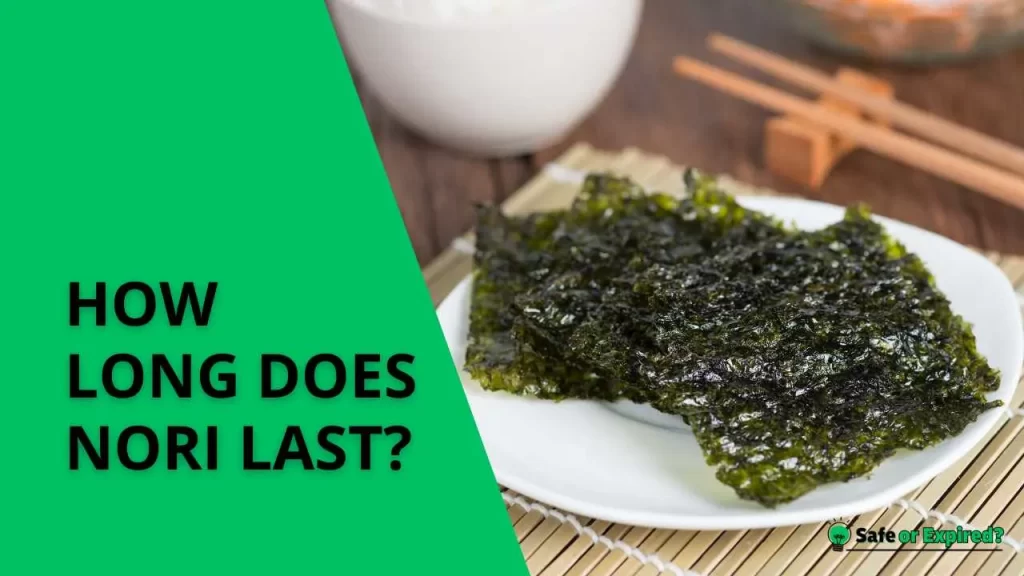“How long does nori last?” is a question important for maintaining a healthy diet. Unopened nori can last up to 2 years, while opened nori should be consumed within 2 to 3 weeks. The exact shelf life depends on some factors, which I am discussing in detail here.
So, keep reading and learn all the crucial details, including the best ways to keep your nori fresh and tasty!
How Long Does Nori Last?
Nori, a type of dried seaweed, generally lasts for a long time if stored properly. Unopened nori can last for up to 1 to 2 years when kept in a cool place away from direct sunlight. Once opened, it should be consumed within 2 to 3 weeks.
Let’s now discuss Nori’s shelf life in different situations.
How Long Does Nori Last Unopened?
Unopened nori can last up to 1 to 2 years if stored correctly. The key to maintaining its longevity is to keep it in a cool place, away from direct sunlight and moisture. Proper storage helps preserve its flavor, texture, and nutritional value.
How Long Does Nori Last After Opening?

Once opened, nori should be consumed within 2 to 3 weeks for the best quality. Exposure to the outside atmosphere (air and moisture) can cause the nori to lose its crispness and flavor. To extend its shelf life, store the opened nori in an airtight container and keep it in a dry place.
Refrigeration can help, but it’s essential to protect it from humidity.
How Long Does Nori Last in the Refrigerator?
Storing nori in the refrigerator can extend its shelf life to about 4 to 6 weeks after opening. However, it’s important to keep it in an airtight container/jar to prevent moisture from affecting its quality. Refrigeration slows down the degradation process, but humidity inside the fridge can still pose a risk if the nori is not properly sealed.
Here’s the Nori’s shelf life table to sum everything up:
| Counter | Fridge | Freezer | |
| Opened | 2 – 3 weeks | 4 – 6 weeks | 6 months |
| Unopened | 1 – 2 years | 1 – 2 years | 1 – 2 years |
4 Factors That Affect the Shelf Life of Nori
The shelf life of nori depends on factors like storage conditions, exposure to air and moisture, packaging quality, and temperature. Each factor can increase or decrease the shelf life. Remember that focusing on all four factors can help you avoid any frustration in the future.
Storage Conditions
Proper storage conditions are essential to keep nori fresh and tasty. Nori should be kept in a dry place, away from direct sunlight. When exposed to light and heat, nori can lose its crispness and flavor.
In my opinion, the kitchen cabinet is a good place to store unopened nori. If you have opened the package, make sure to put the remaining nori in an airtight container. This keeps out moisture and air that can make the nori go bad quickly.
Exposure to Air and Moisture
Air and moisture are the biggest enemies of nori. When nori is exposed to air, it can absorb moisture from the environment. This makes the nori soggy and less enjoyable to eat. To prevent this, always seal the nori tightly after opening.
If possible, use a vacuum-sealed bag or an airtight container. Also, keep it away from damp places like next to the stove or sink. Keeping nori dry is key to making it last longer.
Packaging Quality
The quality of the packaging plays a big role in how long nori will last. Good quality packaging can protect nori from air, moisture, and light. When buying nori, look for packages that are sealed properly and not damaged.
Some nori come in resealable packages, which are great for keeping it fresh after opening.
Temperature
Temperature also affects the shelf life of nori. Nori should be kept at a stable, cool temperature. Fluctuations in temperature can cause condensation inside the package, leading to moisture buildup. If you live in a hot and humid area, consider storing nori in the refrigerator.
However, make sure to keep it in an airtight container to protect it from humidity inside the fridge. Proper temperature control helps keep nori crisp and delicious for a longer time.
These factors—storage conditions, exposure to air and moisture, packaging quality, and temperature—are crucial to maintaining the freshness and taste of nori. By taking care of these, you can enjoy your nori at its best for a long time.
How To Tell if Nori Is Bad? 4 Critical Signs
To tell if nori is bad, check for changes in color, texture, smell, and taste. Bad nori may look discolored, feel damp or sticky, have an unpleasant odor, or taste off. Always store nori properly to maintain its freshness.
Change in Color
One of the first signs that nori has gone bad is a change in color. Fresh nori is usually dark green or black.

If you notice that the nori has turned a lighter shade or if it has spots of yellow or brown, it might be spoiled. Discoloration can mean that the nori has been exposed to moisture or air for too long. This can affect its taste and quality. If you see any unusual colors, it’s best to throw the nori away to be safe.
Texture
Texture is another important factor to check. Fresh nori is crisp and dry. If your nori feels damp, sticky, or soft, it may have absorbed too much moisture. This can happen if the nori is not stored in an airtight container. Moisture can make the nori soggy and make it less enjoyable to eat. To test the texture, gently touch the nori sheet. If it doesn’t feel crisp or breaks easily, it’s likely gone bad.
Smell
The smell is a strong indicator of Nori’s freshness. Fresh nori has a mild, seaweed-like scent. If your nori smells strong, fishy, or unpleasant, it may be spoiled. Bad nori can develop a musty or sour odor, which means it’s no longer good to eat.
Always give your nori a quick sniff before using it. If it smells off, it’s best to discard it to avoid any risk.
Taste
The taste test is another way to tell if nori is bad. Fresh nori has a pleasant, slightly salty flavor. If you notice that the nori tastes stale, bitter, or just different from usual, it’s probably not fresh anymore. Tasting a small piece can help you decide whether to keep or throw it away. If the flavor is off, it’s a clear sign that the nori has gone bad and should not be used.
By checking the color, texture, smell, and taste of your nori, you can easily tell if it’s still good to eat. Remember to store nori properly to keep it fresh for as long as possible.
What Happens if You Eat Expired Seaweed? The Side Effects
Eating expired seaweed might not always make you sick, but it can taste bad and have less nutritional value. In some cases, expired seaweed can cause stomach upset or food poisoning if it has been contaminated. You should always look for signs of spoilage before consuming.
Stomach Upset
One possible side effect of eating expired seaweed is stomach upset. This can include symptoms like nausea, cramps, and diarrhea. The stomach upset happens because the seaweed might have started to break down, and bacteria can grow on it. Even if it doesn’t make you very sick, it can still make your stomach feel uncomfortable.
If you feel any of these symptoms after eating seaweed, it’s a good idea to drink plenty of water and rest.
Food Poisoning
In more serious cases, eating expired seaweed can lead to food poisoning. Food poisoning occurs when harmful bacteria or toxins are ingested with the spoiled food. Symptoms of food poisoning include severe stomach pain, vomiting, fever, and diarrhea. These symptoms can be more intense and may require medical attention.
To avoid this risk, always check your seaweed for any signs of spoilage like a bad smell, discoloration, or unusual texture before eating it.
Reduced Nutritional Value
Expired seaweed can also lose its nutritional value over time. Fresh seaweed is packed with vitamins, minerals, and antioxidants that are good for your health. However, when seaweed goes bad, it can lose these important nutrients. Eating expired seaweed might not give you the same health benefits as fresh seaweed.
It’s always best to consume seaweed while it’s still fresh to get the most out of its nutritional content.
Bad Taste
One of the most noticeable signs of expired seaweed is a bad taste. Fresh seaweed has a pleasant, salty flavor that many people enjoy. When it goes bad, the taste can become stale, bitter, or just plain off. Eating seaweed that tastes bad is not enjoyable and can ruin your meal. If you notice that your seaweed doesn’t taste right, it’s best to throw it away.
Proven Tips for Extending the Shelf Life of Nori
To extend the shelf life of nori, store it in a dry place, keep it in an airtight jar, avoid exposure to moisture, and refrigerate or freeze it if necessary. Proper storage helps maintain its crispness and flavor.
Store in the Correct Place
Keeping nori in a cool, dry place is crucial for maintaining its quality. Heat and humidity can cause nori to degrade quickly, making it less crispy and flavorful. A kitchen cabinet (away from the stove and sink) is an ideal spot.
Avoid areas that get direct sunlight or are prone to temperature fluctuations. Consistent, cool temperatures help preserve the nori’s texture and taste, ensuring it lasts as long as possible.
Use an Airtight Container
Once you open a package of nori, transferring it to an airtight container is essential. Exposure to air can make nori absorb moisture and become soggy.
This simple step helps maintain its crispness and flavor. If the original packaging has a resealable feature, make sure it is sealed tightly after each use to keep the nori fresh.
Avoid Exposure to Moisture
Moisture or humidity is one of the main enemies of nori. Even a small amount of moisture can make nori soft and less enjoyable to eat. To avoid this, keep nori away from damp places and never store it near the stove or sink.
If you live in a humid area, consider adding silica gel to the container. Silica gel absorbs moisture and helps keep the nori dry. Always ensure your hands are dry when handling nori to prevent transferring moisture to it.
Refrigerate or Freeze if Necessary
If you have a large amount of nori or live in a very humid climate, refrigerating or freezing it can be a good option. When refrigerating, place the nori in an airtight container to protect it from humidity. Freezing is also an effective way to extend its shelf life.
Simply place the nori in a freezer-safe bag or container. When you’re ready to use it, let it come to room temperature before opening the container to prevent condensation from forming on the nori.
By following these tips, you can ensure your nori stays fresh and crispy for as long as possible. Proper storage and handling are key to enjoying nori at its best.
Comparing the Shelf Life of Nori with Other Seaweeds
Nori generally has a longer shelf life compared to other seaweeds like wakame and kombu. While nori can last up to 2 years when unopened and stored properly, wakame and kombu typically last six months to a year.
Remember that proper storage conditions, such as keeping them in a cool place and using airtight containers, are essential for all types.
Seaweed Shelf Life Comparison Table
| Seaweed Type | Unopened (Cool, Dry Place) | Opened (Room Temperature) | Opened (Refrigerated) | Opened (Frozen) |
| Nori | 1 – 2 years | 2 – 3 weeks | 4 – 6 weeks | 6-7 months |
| Wakame | One year | 1 – 2 weeks | Three weeks | 6-7 months |
| Kombu | Four weeks | 1 – 2 weeks | Six months | 6 months |
Conclusion
Nori is a delicious and versatile seaweed that can last a long time if stored properly. Here’s a quick recap:
- Unopened nori can last up to 2 years.
- Opened nori is best consumed within 2 to 3 weeks.
- Refrigerating opened nori can extend its shelf life to 4 to 6 weeks.
- Proper storage conditions are key to maintaining nori’s quality.
Now, you can enjoy fresh and tasty nori for a longer period. Happy snacking!

